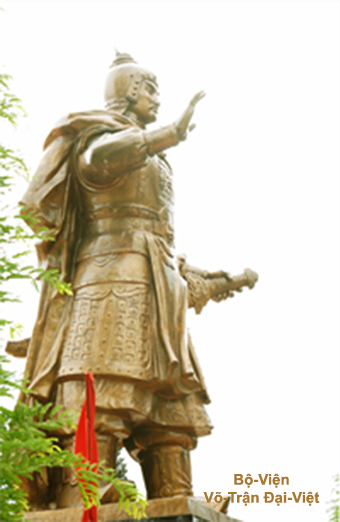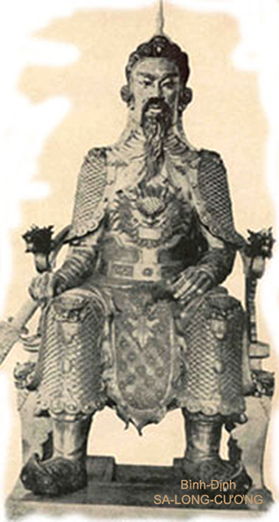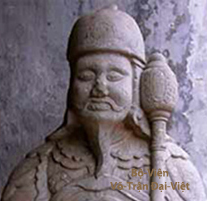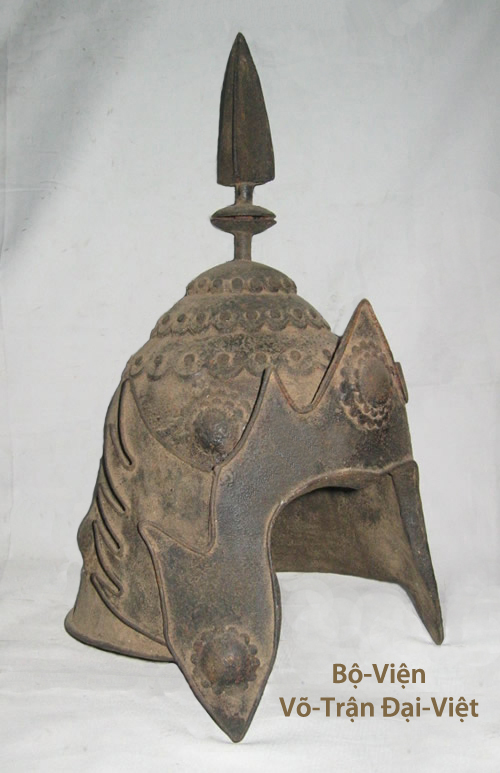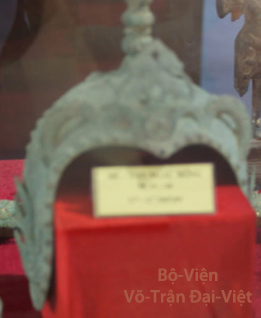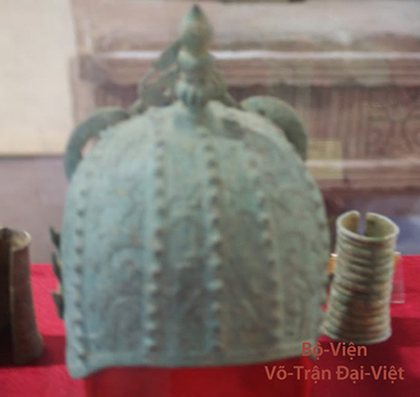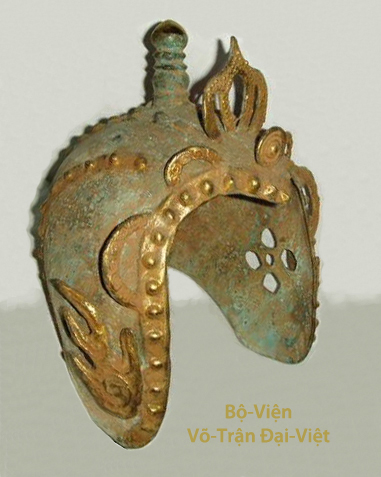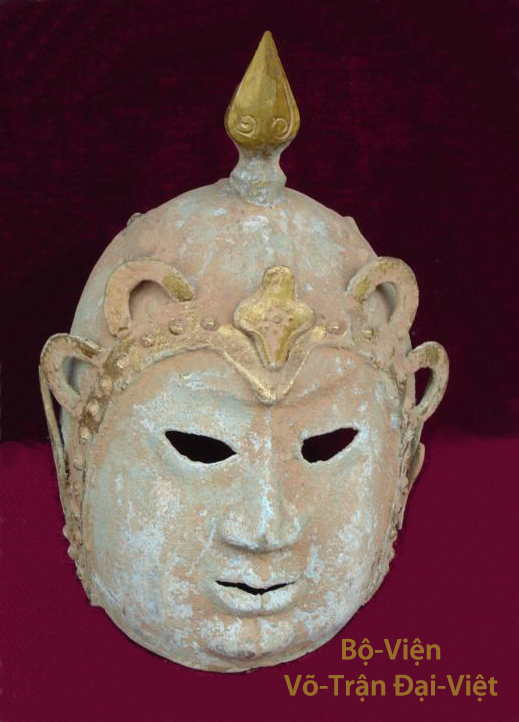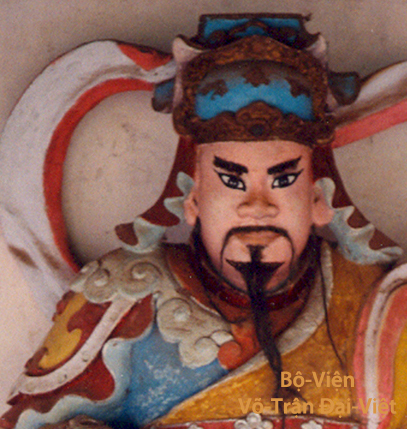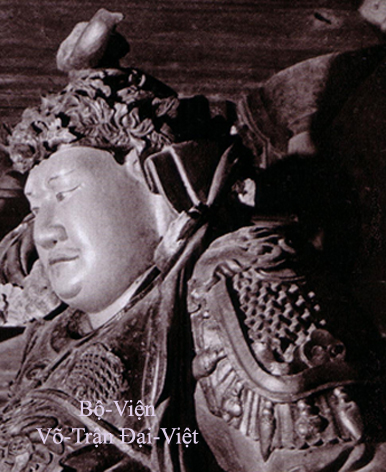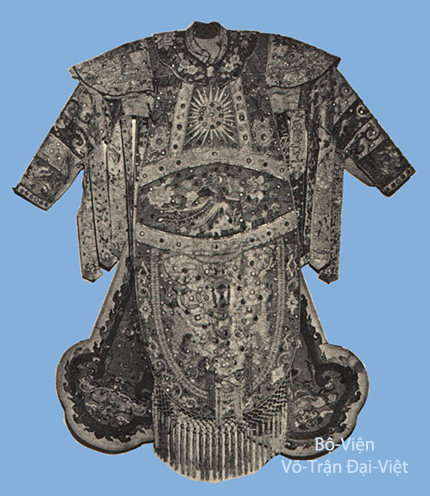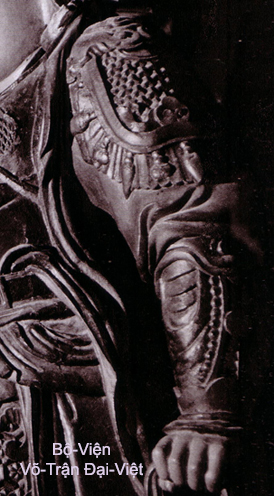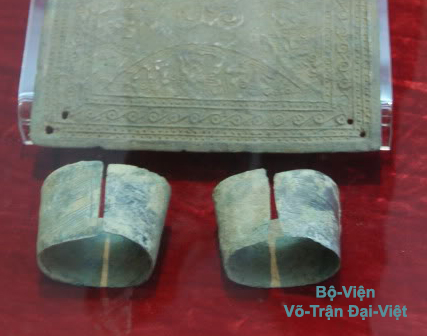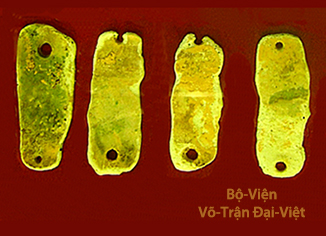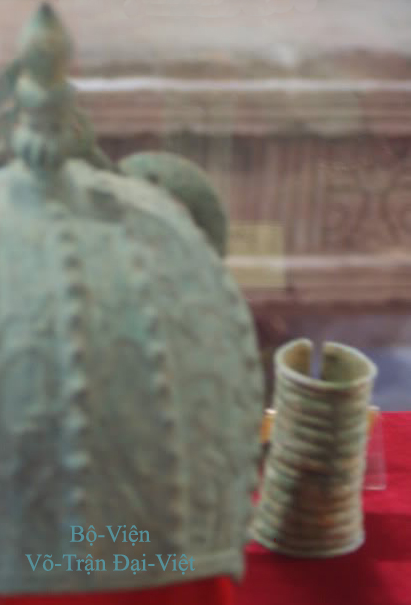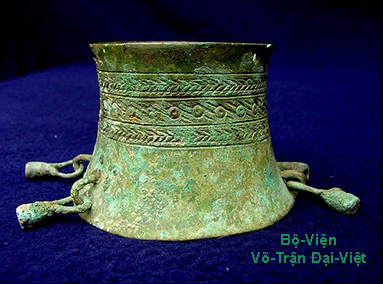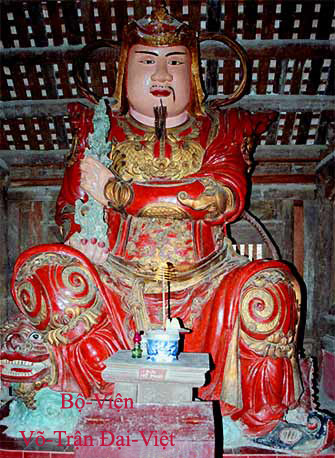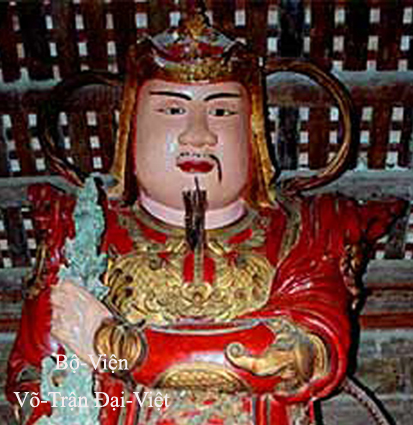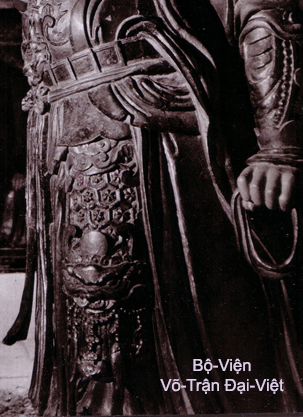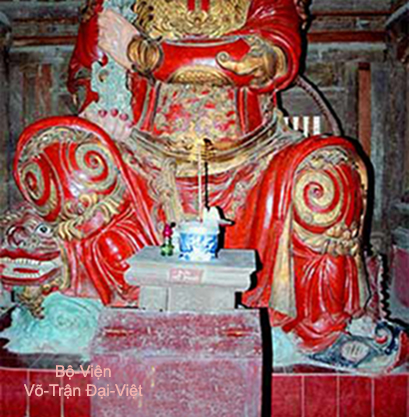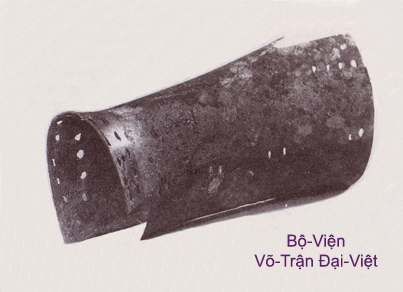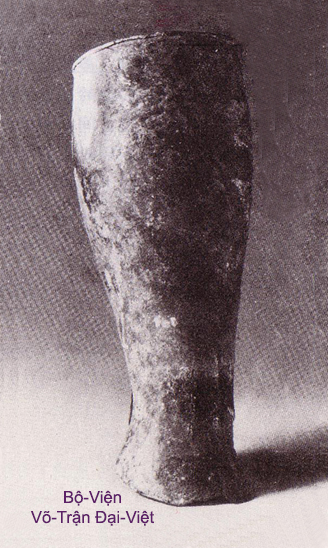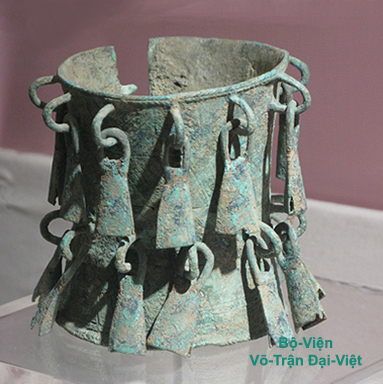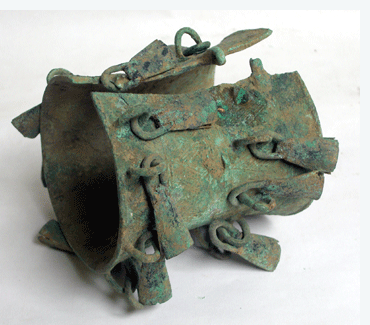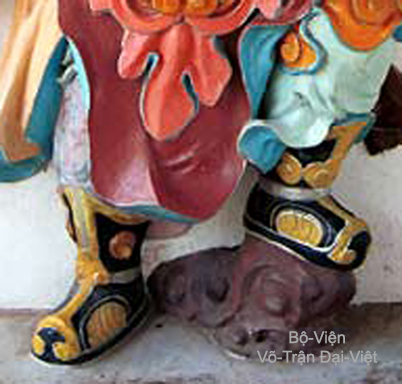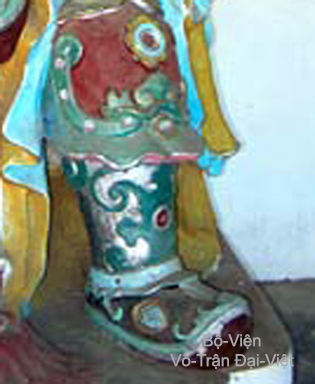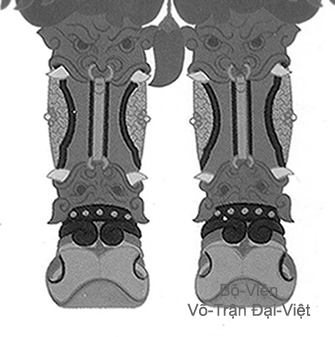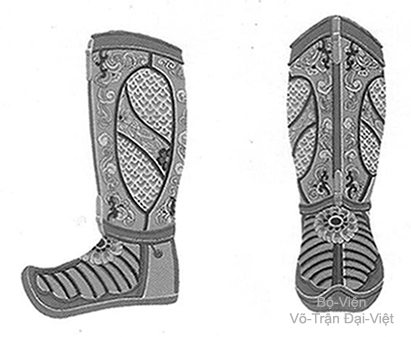V.
THE ARMOURS
鎧 甲
D - Historic Re-Enactment
When we see, for example, a statuary of Quang-Trung Nguyễn-Huệ Emperor from Tây-Sõn Dynasty (1788-1792), depicting him wearing an Armour from TRẦN Dynasty (1225~1400), this illogical anachronism - four-centurles interval - we have immediately an idea that the Historic-Re-Enactment of Armours is a fact which deserves to be encouraged. Even if it doesn't exist nowadays a cliver craftsman capable to forge Armours perfectly conform to historic models, on the fondamental architectural realization of Armours based on historic documents and relics of the past would be always a judicious thing.
Statue of Emperor Quang-Trung NGUYỄN-Huệ 1788~1792 |
Statue of Generalissimo TRẦN Hưng Đạo (1213~1300)
|
Before setting about doing the Armour's Historic Re-Enactment, it's necessary for us, not only to know the Synoptique of the Armour's Evolution and to do the Armour's Comparative Study throughout the Periodes of Dynasties, but it's still necessary for us to know making the Distinction of Armour's Categories, to carry out Researches on Characteristiques of Armours in order to decide afterwards the category or categories that we want to realize the reconstitution.
I - The Distinction of Armour's Categories
The term Armour uses to designate commonly protector clothing of warrors going to battle-fields.
In reality, the Armour is divided into several categories :
I - The Category of Armours for on foot fighting, comprising two kinds :
A - The one reserved to Infantry Generals and Infantry Officers, always owning Pauldrons (Thủ-Kiên-Giáp) on top of that the Helmet, the Breast-plate and the Back-plate :
a - the Pauldrons (Thủ-Kiên-Giáp) - that are pieces of armour using for the shoulder joint protection ;
b - theTassets of Crotch (Hạ Bàn-Giáp) - that are pieces of armour using for the protection of lower abdomen parts and of the lower back parts, during the moving legs further apart in fighting posture (Trung-Bình-Tấn, Đinh-Tấn) ;
B - The one reserved to Footsoldiers never owning Pauldrons and which divides up into two kinds of Armour :
1) Armour holding a Breast-plate (Hung-Giáp) but neither Cuishes (Đại-Thối Giáp) nor Back-plate (Bối-Giáp) ;
2) Armour holding Cuishes and Back-plate on top of that the Breast-plate (Hung-Giáp).
II - The Category of Armours for on horseback fighting, comprising two kinds :
A - The one reserved to Cavalry Generals and Cavalry Officers, always owning Pauldrons (Thủ-Kiên-Giáp) on top of that the Helmet, the Breast-plate and the Back-plate, but which never owns Tassets of Crotch (Hạ Bàn-Giáp), because that is to fight on horseback ;
B - The one reserved to Cavalry Soldiers owning no Pauldrons (Thủ-Kiên-Giáp) but holding Cuishes and Back-plate on top of that Breast-plate.
Statue of Đại-Việt Warrior in Infantryman Armour
|
Statue of Đại-Việt Warrior in Cavalry Armour
|
II - The Characteristiques of the Armour from Đại-Việt (from three Dynasties LÝ, TRẦN and LÊ)
A - War Helmet has these characteristiques following :
1 - Helmet called Đâu-Mâu 兜 鍪 is with low Crest in roundness shape with no plume (Fig.01) ;
2 - Helmet called Khôi-Mạo 盔 帽 is holding a pointed high Crest with plume, Ears Protection in Fire Pearl shaped and in addition Arches for protecting temples (Fig.03 & Fig.05), and even a fixed Visor in a Mask shaped (Fig.06) ; later, it's holding lateral protection in the form of Flying Phoenix Wings that is the reason of his name of "Flying Phoenix Wings (Phượng-Dực Mạo 鳳 翊 帽 )" (Fg.02).
Fig. 01 - Statue of Warrior with the Helmet "Đâu-Mâu" 兜 鍪 |
Fig. 02 - Helmet holding Ears Protection in
|
Fig.03 - Helmet holding Ears Protection |
Fig.04 - Helmet holding Ears Protection in Fire Pearl shaped
|
Fig.05 - Helmet holding Ears Protection in Fire Pearl shaped |
Fig.06 - Helmet holding Ears Protection in Fire Pearl shaped
|
B - War Armour has these characteristiques following :
1 - Shoulder Harness made up of Pauldrons (Thủ-Kiên-Giáp 頭 肩 甲) designed in cloud flakes shaped covering the shoulder joint (Fig. 07), sometimes in the Tiger-Head-shaped.
Fig.07 - Statue of Dharmapâla in Armour holding |
H.08 - Statue of Dharmapâla in Armour holding
|
a) The Chest Protection - Breats-plate Hung-Giáp 胸 甲 : it was designed very early in bygone days with fibers of Coconut or with Wicker. Then since the Bronze Period, the Breats-Plate was designed under the form of a Square or rectangular Plate, called Hộ-Tâm Phiến (Heart Protector Plate) (Fig.09 ; Fig.10). Well more later, it was since Iron Age that the Breats-Plate was designed in accordance with the model from medieval Armour Khải-Giáp ( 鎧甲).
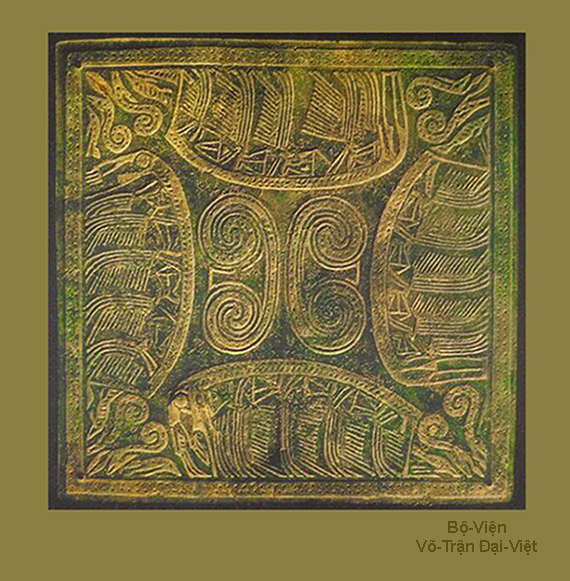
Breast-Plate under the form of Square Plate, said "Heart Protector Plate" ( Hộ-Tâm Phiến).
- Hồng-Bàng Dynasty Period (2879~258BC) -
(Photo Credit : Ngọc Thắng)
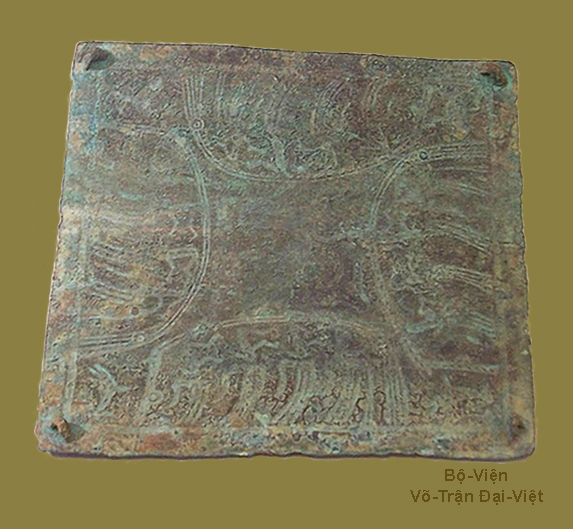
Breast-Plate under the form of Square Plate, said "Heart Protector Plate" ( Hộ-Tâm Phiến).
- Hồng-Bàng Dynasty Period (2879~258BC) -
(Photo Credit : Ngọc Thắng)
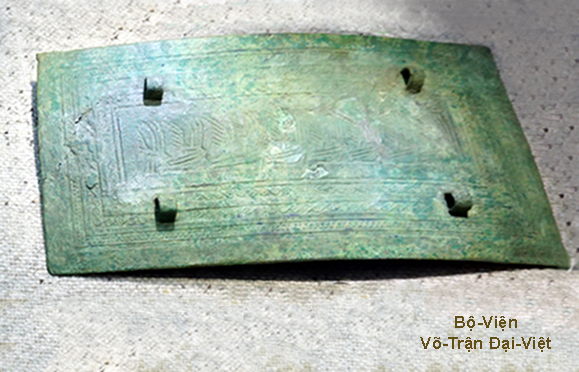
Breast-Plate under the form of Rectangular Plate, said "Heart Protector Plate" ( Hộ-Tâm Phiến).
- Hồng-Bàng Dynasty Period (2879~258BC) -
(Photo Credit : Ngọc Thắng)
3 - The Protection of the Upper Limbs : it is constituted by the Leg harness (Hạn-Giáp 釬甲) comprising Three parts :
a) The Rerebraces (Thượng-Bác-Giáp 上 膊 甲) (Upperarm Harness) under the shape of Spallières, holding Armpit Harness Dịch-Oa-Giáp 腋 窩 甲 made of leather straps flapping idly against the flank (Fig.09).
b) The Vambraces (Hạ-Bác-Giáp 下 膊 甲)(Forearm Harness) designed in rings welded into split cylinder-shaped (Fig.04 ; Fig.11) untill Circa 14th ~ 15th Century (Fig.04 & Fig.09), and later more advanced (Fig.13 ; Fig.14 ; Fig.17 ; Fig.10).
c) The Elbow Cops (Trữu-Giáp 肘 甲) (Elbow Harness) often in Fire Pearl or in Cloud Flakes stylized shapes (Fig.14 ; Fig.15 ; Fig.16).
Fig.09 - Silk Armour under NGUYỄN Dynasty
|
H.10 - Rerebrace (Thượng-Bác-Giáp 上 膊 甲) (Upperarm Harness)
|
Fig.11 - Vambrace (Hạ-Bác-Giáp 下 膊 甲) |
H.12 - Ecailles de Broze - Đồng-Giáp 銅 甲 |
Fig.11 - Vambrace (Hạ-Bác-Giáp 下 膊 甲) |
H.14 - Vambrace (Hạ-Bác-Giáp 下 膊 甲) |
H.13 - Elbow Cops (Trữu-Giáp 肘 甲) |
H.14 - Elbow Cops (Trữu-Giáp 肘 甲)
|
4 - The Protection of the Lower Limbs : it is constituted by Leg harness (Thối Giáp 腿 甲) comprising Three parts :
a) Cuishes (Đại-Thối Giáp 大 腿 甲) (Fig.15) ;
b) Poleyns (Tất-Giáp 膝 甲) (Fig.16) ;
c) Greaves (Tiểu-Thối Giáp 小腿 甲) (Fig.15) .
H.15 - Cuish (Đại-Thối Giáp 大 腿 甲), |
H.16 - Poleyn (Tất-Giáp 膝 甲 - Knee Protection)
|
Fig.17 - Vambrace (Hạ-Bác-Giáp 下 膊 甲) |
Fig.18 - Greave (Tiểu-Thối Giáp 小腿 甲)
|
H.17 -Grève (Tiểu-Thối Giáp 小腿 甲) |
H.18 - Grève (Tiểu-Thối Giáp 小腿 甲)
|
5 - The Protection of the Feet : it is constituted by Feet Harness defended by Cothurnes (War Boots) comprising three parts :
a) The Shin protection(Fig. 19 ; Fig.20 ; Fig.21) ;
b) The Top of the Foot protection (Fig. 19 ; Fig.20 ; Fig.22) ;
b) The Achiles Heel protection (Fig. 19 ; H.22).
Fig.19 - War Boots (Shin Protection ; |
Fig.20 - War Boots (Shin Protection ; |
Fig.21 - War Boots from |
Fig.22 - War Boots from
|
(To be continued...)
ACADEMIY |
A - Synoptic of the Armour's Evolution
B - Armour's Comparative Study
C - The Historic Re-Enactment - (Photos Gallery)
Copyright © 2004 - 2017 by ACFDV - All rights reserved
